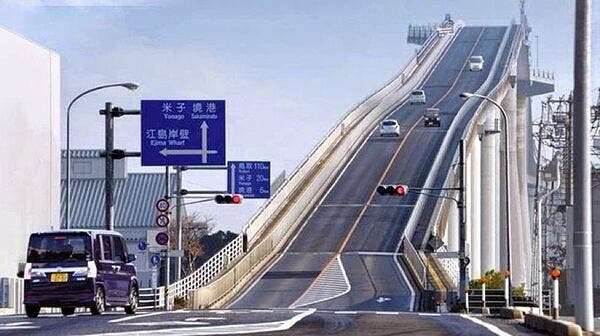Modern marvels of engineering, bridges have been around since the dawn of civilization. They take multiple sizes and forms, consisting of a variety of materials. Some are taller, some are prettier, and some are simply spectacular.
But which is the longest bridge in the world? Well, that’s a question with a fair amount of controversy, as any story.
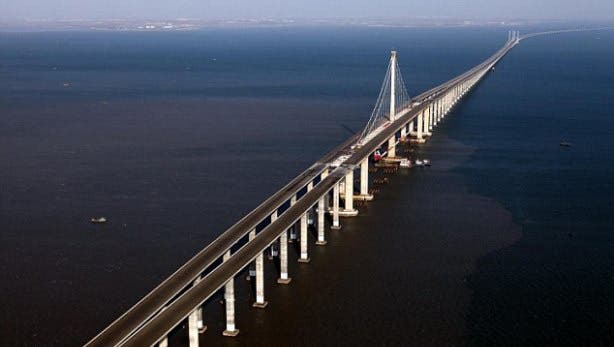
Building bridges started in prehistory when a man presumably decided to bring down a tree and connect two strands. There was not much science to the first bridges, although by the Antiquity, the craft of bridge-making had already become quite advantaged.
Wooden bridges were among the favorite ones since ancient times. A few examples can still be seen across the world, such as the Holzbrücke Rapperswil-Hurden in Switzerland. Romans built this type of bridge extensively, and they are even making somewhat of a comeback now as they are more environmentally friendly than other materials (and can be quite cheap).
Stone and wood have also been highly popular throughout time, especially during the Napoleonic times, as they were during the time of Julius Cesar. Cast and forged iron weren’t available for bridges until the end of the XVIII century, mainly because of its high prices.
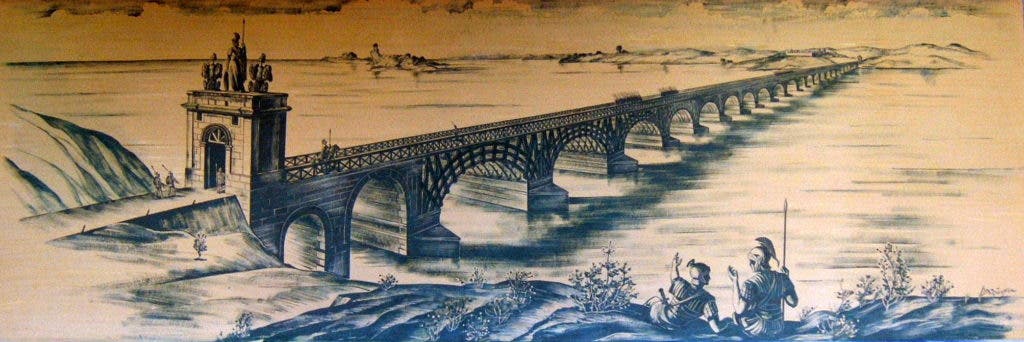
The construction of bridges evolved mirroring the needs and desires of constructors. The first spur was when Rome dominated most of the world. As they conquered new countries, they set up wooden and stoned bridges to aid travel within the Empire. When the empire fell, bridges had a major setback that lasted for more than six centuries — as was the case with many engineering feats following the decline of the Romans.
“The steam engine then started a new era. New railway networks forced bridge building to expand with more solid and resistant materials. Then, the car created a never seen demand of bridges, using taxes o finance them. In just a few decades the most notable bridges were built,” Tomás del Carril, bridge expert from Argentina, told ZME Science.
What are bridges made of?
The main function of the bridge is to set up a stable decking that allows transporting pedestrians, vehicles or trains, supporting the weight of the structure, the traffic and the natural elements that affect its durability.
Each bridge is designed based on the function, the weight, the winds and the characteristics of the land in which it will have its base. The project is supervised by an engineer, with many designs been used through time, influenced by the materials available, the techniques and the funding.
There are a wide variety of materials used by engineers, with some used more than others depending on the time of history. These are some of the most used materials in bridge building, with new materials coming up all the time:
- Natural materials. At first, bridges were only built with unprocessed natural materials such as wooden longs placed over rivers or rope-tied bridges set up over canyons and mountain ranges. It’s still common to see some of these when visiting a national park or reservoir.
- Wood. Wood is a very good material to build bridges small or medium, especially for pedestrians or for not that heavy vehicles. They are used for short distances and to transport people, livestock and vehicles over small rivers and rough land. They were among the first bridges to be developed and are still used a lot.
- Concrete and steel. These were among the most modern materials to come up in bridge construction and can now be seen in many bridges across the world. They are durable, long-lasting and versatile materials, which are usually used in combination with other materials.
What are the main types of bridges?
Built in different materials, bridges can have different shapes and styles. Here are some of the main ones:
- Arch bridge. These bridges use the arch as the main structural component. The number of arcs needed varies depending on what type of load and stress forces they must bear. They allow the use of simple materials, such as stone and the like, cement, fillers, mass concrete (not reinforced) or brick.
- Beam bridges. They are among the oldest and simplest bridges and can be inclined or V-shaped. They are supported by several beams that can be vertical or horizontal. The strength of the bridge depends on the strength of the route and can be multiplied by adding more piers. They are usually quite long.
- Suspension bridges. They are bridges that use vertical league ropes or cables to support the weight of the bridge deck and traffic. The ropes are usually connected by two towers. They can cross distances between 2,000 and 7,000 feet (610 and 2,134 meters).
- Transporter bridge. It’s a type of bridge that to cross a canal or a river is helped by a gondola or ferry, where vehicles and people enter, that travels not too high from the water from one shore to another, suspended by cables of a cart that slides under the board.
- Movable bridge. It’s a structure with the ability to move, usually with the purpose of opening the way to vessel traffic over its location, thus generating a series of economic advantages in the project derived from the saving in the cost of docks. There are several types such as drawbridges, swing bridges and moving bridges.
- Truss bridge. This design uses a load-bearing superstructure composed of a truss, a structure of connected elements usually forming triangular units.

Of course, there are multiple types of bridge designs, depending on their structure, design, or function. Let’s go down to see which one is the longest.
The longest bridge (over water)
The longest bridge in the world is located in China, as well as many other record-breaking structures. According to the Guinness Book of Records, the longest bridge over water is the Jiaozhou Bay Bridge, also known as the Qingdao Haiwan Bridge. Its construction finished in 2011 at the Shandong Peninsula.
The bridge got the award because of covering 26,4 miles. It has 5,200 pillars supporting it and about 450.000 tons of steel and 2,3 million cubic meters of concrete were used for its construction. It was designed to tolerate earthquakes, typhoons and even with the impact of a sheep of up to 300,000 tons.

Giving the record to the Jiaozhou Bay Bridge meant taking it away from the previous holder, which was Louisiana’s Lake Pontchartrain Causeway in the south part of Louisiana. Nevertheless, that’s also a very important construction that should be celebrated.
The bridge spans 23.8 miles and runs over continuous water, instead of having tunnels and lanes as the bridge in China. The project of the bridge goes back to the XIX century, with a part of it inaugurated in 1956 and another part in 1969.
The longest bridge (on land)
While the Jiaozhou Bay Bridge and Louisiana’s Lake Pontchartrain Causeway are quite impressive structures, they are truly the longest bridges — just the longest bridges on water. If we want to see the longest overall, we have to go on land, but we’re staying in China.
The longest bridge in the world is the Dayang-Kunshan Grand Bridge in China.

The bridge is part of a high-speed railway system and has a length of 104,2 miles (167,3km). It was inaugurated in 2011 and built-in just for years thanks to the work of 10,000 workers, with a cost of 8,5 million. It crosses rice paddies, the Yangtze River Delta and the Yangcheng Lake in Suzhou.
The train that goes through the bridge runs at 300 kilometers per hour, covering 24 stations. The line connects Beijing with Shanghai in less than five hours, going through 1,318 kilometers. More than 40 trains per day use the line, passing through the Dayang-Kunshan Grand Bridge
The longest suspension bridge
Now that we’ve looked at the record holders, let’s have a look at some of the special categories. For instance, suspension bridges.
A suspension bridge is supported by an inverted arch formed by numerous steel cables, from which the bridge board is suspended by vertical braces. They represented a big leap in bridge design and now many can be found in different parts of the world.
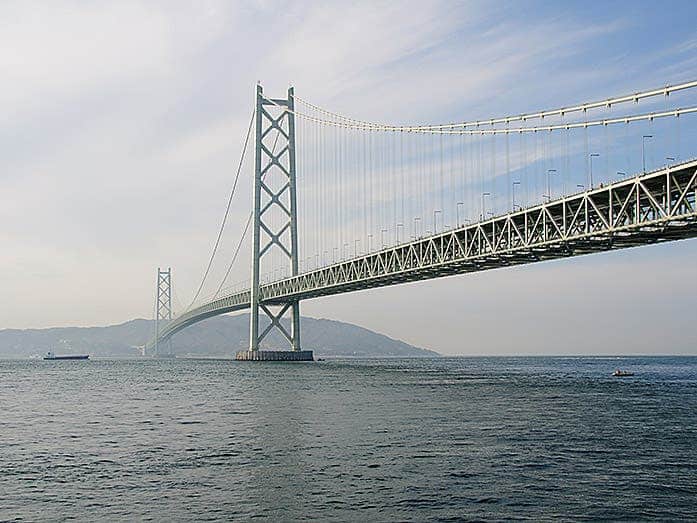
While the Golden Gate Bridge in San Francisco is probably one of the most known suspension bridges, the Akashi Kaikyo Bridge in Japan (also known as the Pearl Bridge) holds the title for the world’s longest, tallest and most expensive suspension bridge.
The bridge is 2,4 miles long (3,8km) and 280 meters tall and connects the city of Kobe with Awaji Island. It carries about 23,000 cars a day between the two strands, making it not only a useful but also a beautiful bridge.
The bridge holds another enviable record: it was built to tolerate an 8,5 magnitude earthquake, winds of up to 180mph, and typhoons — all of which are relatively common in the region. It has a six-lane highway and is designed to last for 200 years.
The longest movable bridge
Usually, when you think of a bridge the image that comes to mind is a fixed one, with no movement and staying in the same place until it’s demolished. But that’s not always the case thanks to the movable bridges, which can open to let boats pass through.

There are several well-known around the world such as the Tower Bridge in London and the Puente de la Mujer in Argentina. But there’s one that stands out for being the longest: the Broadway Bridge in Portland, Oregon.
The bridge opened in 1913, which a new approach added in 1927, and has a length of 1,613 feet. Its opening can take up to 20 minutes, which is more than the average of other movable bridges. It was designed by Ralph Modjeski.
The longest arch bridge
Located in the city of Shanghai, the Shangai Lupu Bridge is the longest arch bridge in the world. It crosses the Huangpu River and joins the Luwan and Pudong districts with a total length of 3,900 meters.
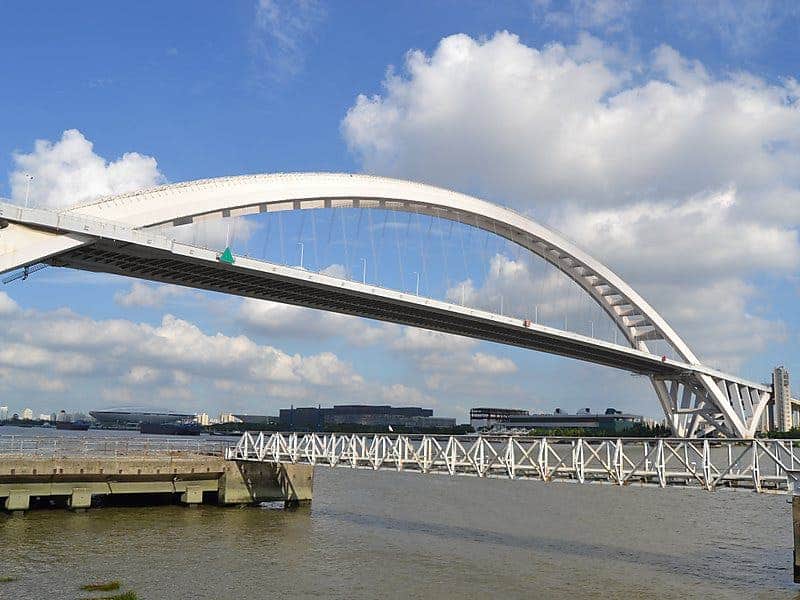
It was inaugurated in 2003 and cost 300 million dollars. More than 34 million kilos of steel were needed for its construction, as well as 120 cables to sustain the highway.
After climbing about 300 steps to the top, you can reach an observation platform above the river that offers some of the best views of the city. It’s one of the tourism highlights in the area.
The tallest bridge
Length isn’t the single measure that can make a bridge impressive. The tallest one in the world, meaning the height of the structure’s tallest point, is the Milau Viaduct in Aveyron, France, considered a masterpiece of engineering for many reasons.
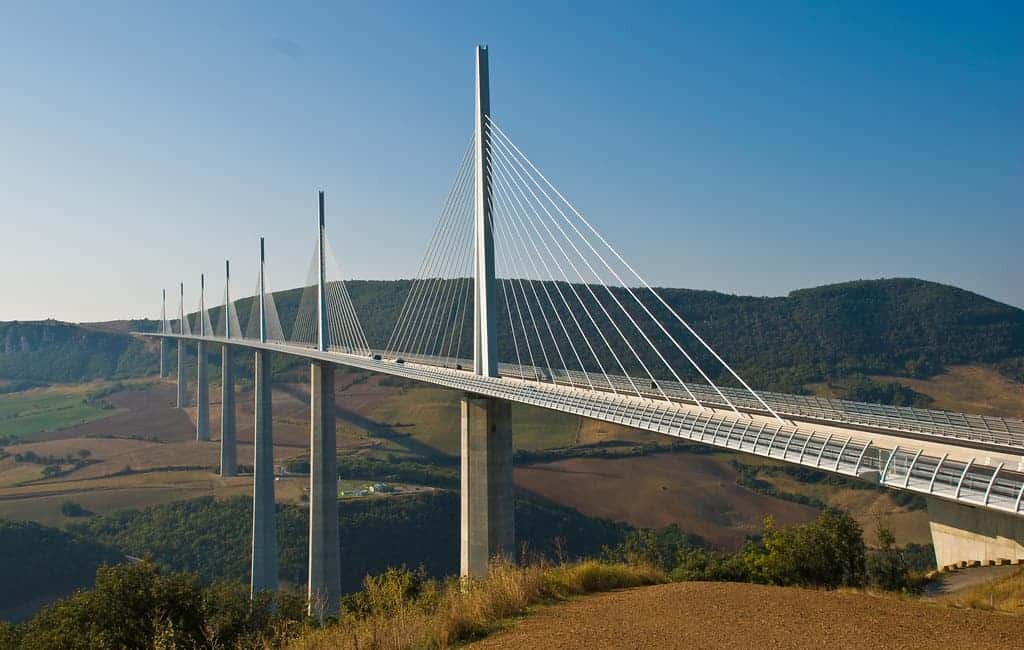
It’s a stayed-cable bridge with a length of 1.5 miles (2.4 km) across the Tarn River Valley. The expressway lanes reach 890 feet at their highest point, but the structure actually towers another 235 feet above for a total height of 1,125 feet.
The bridge’s iconic look is the result of the viaduct’s cable-stayed design, using pylons to hold steel cables that support the weight of the structure’s spans. Its preparation took 14 years and its construction three, starting in 2001 by the company Eiffage.
Due to its design, the bridge received many awards such as the Outstanding Structure Award and the Environmental Design and Architecture Award. About 85,000 cubic meters of concrete were used in its construction, as well as 70,000 tons of sand.
The highest bridge
Reaching the record for the tallest bridge is quite a significant achievement, but there are others to consider. For example, the highest bridge in the world, which means the length between the span of the bridge and the lowest point on the ground.
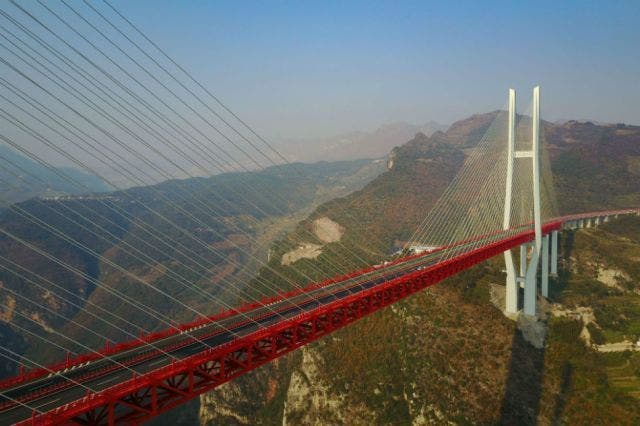
The bridge to break that record is the Duge bridge, also known as Beipanjiang Bridge Duge. It’s located in Guizhou, China and connects the cities of Hangzhou and Ruili, floating over 1,854 feet above the ground.
Construction began in 2011 and was quite difficult due to the high winds and mountains in the area, finishing in 2014. It cost 144 million and it took away the record from the Baluarte Bicentenario bridge in Mexico.
Other notable bridges
India’s Living Roots Bridges. When visiting India, you can see living root bridges, which uses the century-old practice of training fig trees to grow into bridges. Locals manipulate the roots of the trees as they grow and push them together, so to make walkways and river crossings. The process can take up to 15 years and is usually done with fig trees. Examples can be found in many villages of the West Jaintia Hills district and East Khasi Hills district, such as Shnongpdeng and Nongbareh.
Lucky Knot Bridge. Located in the city of Changsha in China, the Lucky Knot Bridge was developed by the China-based Next Architects and inaugurated in 2017. It’s inspired in the Mobius ring, which is a ring that twists, and knotting, folk art from China that uses knots to create different shapes. The bridge crosses the Dragon King Harbour river and goes more than 600 feet in length.
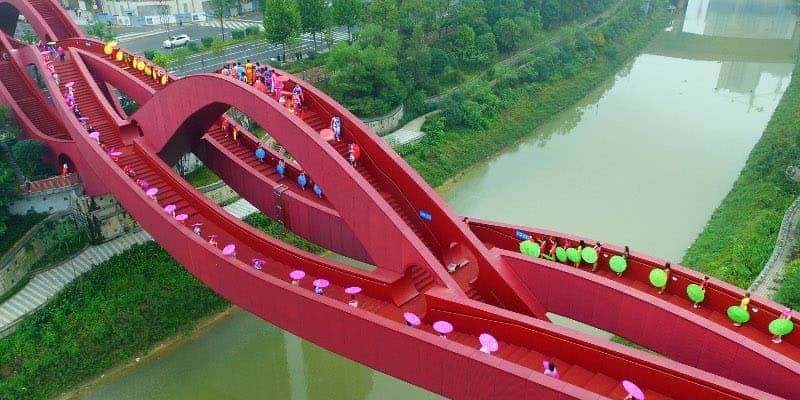
Eshima Ohashi Bridge. Going to the bridge feels like going into a roller coaster, but it’s actually an optical illusion. The structure became an internet hit after being completed in 2004, as images made the bridge’s grade look steeper than what they actually are. It was built over the Nakaumi lake in Japan with iron and steel and it’s a major tourist attraction in the area.
